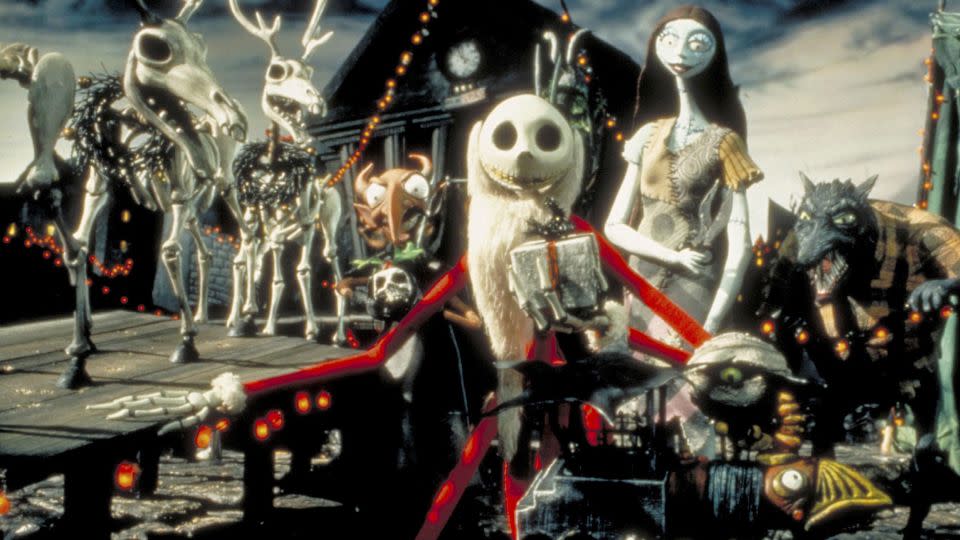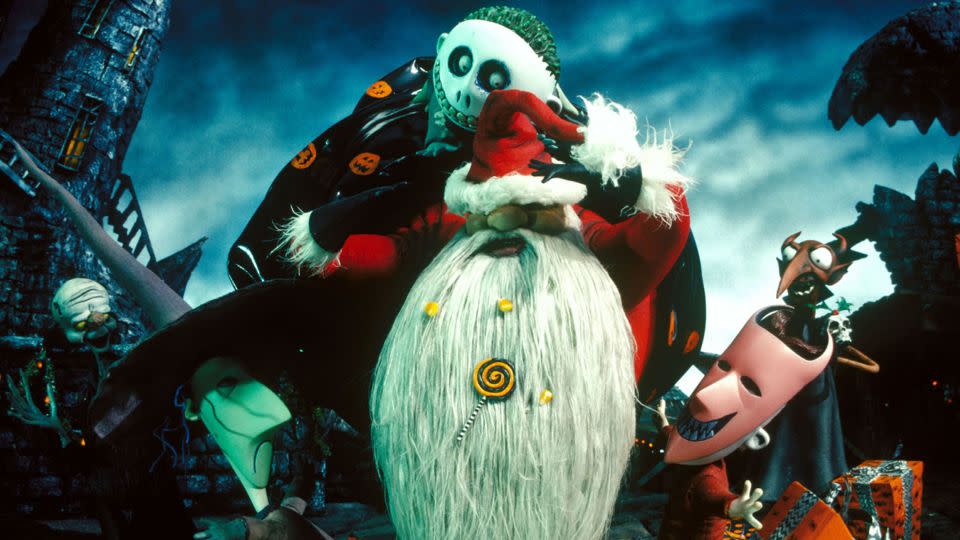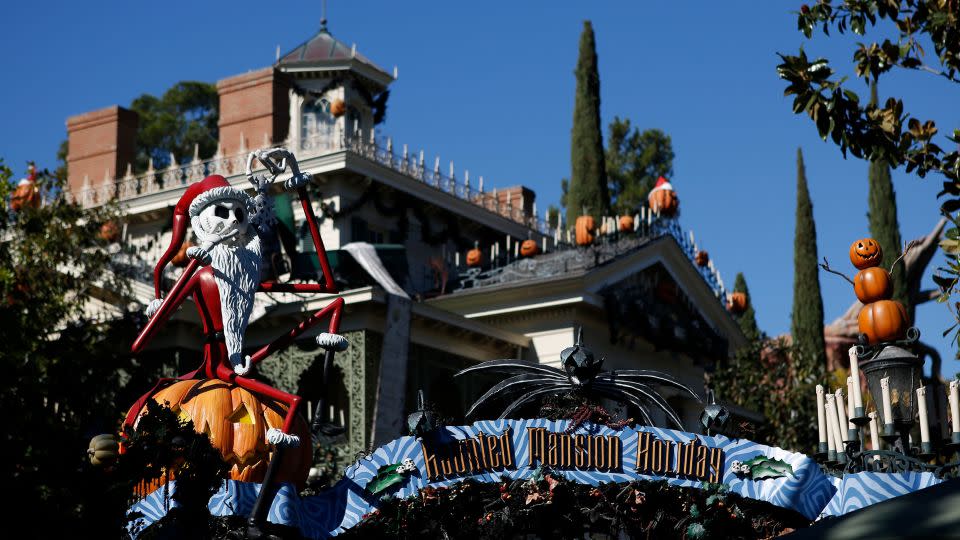How ‘Nightmare Before Christmas’ went from cult classic to beloved Disney property
- Oops!Something went wrong.Please try again later.
- Oops!Something went wrong.Please try again later.
- Oops!Something went wrong.Please try again later.
“The Nightmare Before Christmas” is, today, a proud Disney property. You can find its spindly hero Jack Skellington across Disneyland during Halloween and Christmastime, and his skeletal smile adorns everything from pillowcases to backpacks to Build-a-Bear stuffed creatures. It’s one of the company’s most unique artistic achievements and a proven moneymaker, even 30 years on.
In 1993, though, a Halloween-Christmas film hybrid starring a slightly demented but well-meaning skeleton in a bat bowtie who nearly gets Santa killed was no easy sell. Worried the film would frighten young viewers used to “The Little Mermaid” and “Aladdin,” Disney released the film under its Touchstone Pictures banner, reserved for titles with more mature themes than standard Disney fare (a few years earlier, “Who Framed Roger Rabbit” got the same treatment).
The film made a modest box office dent upon release. But many viewers who found the film over the years, usually on home video, appreciated its impressive puppets, offbeat rhythm and many seasonal earworms. Audience support led to multiple rereleases, elevating the film from a cult classic to a must-watch movie during both Halloween and Christmas.
Thirty years later, Disney has wholeheartedly embraced “The Nightmare Before Christmas.” The company has incorporated the film’s characters into its Haunted Mansion attraction at Disneyland in California. It’s re-released the film several times. And no longer are Jack Skellington and his motley crew of undead dreamers relegated to Hot Topics and novelty shops — now, “Nightmare” characters are sold as stuffed animals and figurines alongside Ariel and Mickey Mouse.
Disney is commemorating the deliciously bizarre film’s 30th anniversary with a theatrical rerelease. Here’s how a small film about a bunch of undead dreamers enchanted viewers — and became an essential offering among Disney’s holiday entertainment.
‘Nightmare’ wasn’t an immediate hit

“Nightmare” was masterminded by Henry Selick and Tim Burton, who got their start as animators at Disney in the 1980s. They found it hard to nail Mickey and other Disney stalwarts, preferring to sketch off-kilter characters: “We weren’t the typical Disney people,” Selick told A.frame, the Academy of Motion Picture Arts and Sciences’ digital magazine, earlier this month.
Burton’s first iteration of “Nightmare” was a poem, populated by ghoulish characters who tried their hand at Christmas. Disney didn’t bite at the time. But after the “Beetlejuice” filmmaker departed the studio and proved his success in helming his first “Batman” film, Disney returned to the project. With Burton directing a “Batman” sequel, Selick was brought on to lead the meticulous stop-motion film, whose production would stretch to over three years, he said.
The beefed-up story saw Jack Skellington, the Pumpkin King and beloved resident of Halloween Town, yearn for a chance to do something other than scare trick-or-treaters. He finds his chance when he stumbles upon Christmas Town, the cheery center of Santa’s operation. He decides to give the man in red the year off, with disastrous results — the evil Oogie Boogie gets his hands on “Sandy Claws” and puts Christmas in peril. Meanwhile, the living rag-doll Sally, who pines for Jack from afar, helps save Christmas — and Jack’s undead life.
Even though Disney execs tapped Selick to bring Burton’s dark-but-big-hearted vision to life, they didn’t expect the film to be a huge hit, Selick told IGN in 2006, ahead of the film’s 13th anniversary rerelease. They feared its cast of murderous child sidekicks, warty witches and a “clown with a tearaway face” would prove too scary for young audiences.

“They never felt (“Nightmare”) was a Disney film,” Selick told IGN. “Their biggest fear, and why it was kind of a stepchild project, was they were afraid of their core audience hating the film and not coming.”
“Nightmare” got a wide release on October 29, 1993, without Disney’s name attached. It made $50 million at the US box office in 1993, a mild success (meanwhile, the highest-grossing film of the year and another dark but crowd-pleasing classic, “Jurassic Park,” made over $357 million in its domestic release). It also earned an Oscar nomination for best visual effects, losing to the aforementioned “Jurassic Park.”
“(It was this initial) small success,” Selick told The Hollywood Reporter in 2018 for the film’s 25th anniversary. “It made double its money, and they made a few toys and it went away. And then it slowly became this other thing.”
‘Nightmare’s’ popularity grew with at-home viewers
In the years after its release, “Nightmare” was embraced by audiences at home who found the film on VHS and, later, DVD. It connected with people, even and perhaps especially young viewers, who felt, like Jack, that they were misunderstood or destined for more than their circumstances allowed.
Roger Ebert said as much in his glowing three-and-a-half star review of the film in 1993: “This is the kind of movie older kids will eat up; it has the kind of offbeat, subversive energy that tells them wonderful things are likely to happen.”
Disney warmed to the film in the years after its release: In October 2001, Disneyland debuted Haunted Mansion Holiday, a “Nightmare”-themed overlay of the classic Haunted Mansion attraction that featured Jack and company redecorating the spooky home for Christmas.

Jack and Halloween Town denizens were also mainstays at stores like Hot Topic, which catered to customers with alternative tastes, where “Nightmare” merchandise was sold year-round. And in 2006, Disney finally released the film under the Walt Disney Pictures banner, this time in 3D, earning more than $8.7 million in the US.
“Disney didn’t know what they had, but eventually they figured it out,” Selick told A.frame.
“Nightmare” characters now make regular appearances at the Disney parks during Halloween and Christmas, greeting young visitors and appearing on seasonal merchandise. Disney films even more explicitly dealt with death: The popular Pixar film “Coco” starred several skeletons, and the studio even released a fully animated version of “Frankenweenie,” based on Burton’s short film of the same name. Burton has even gone on to direct more children’s films for Disney, including “Alice in Wonderland” and “Dumbo,” his dark streak dampened but still intact.
Its cult success also set the stage for other macabre animated children’s films like “Corpse Bride,” also by Burton, “Paranorman” and the Henry Selick-directed “Coraline” — proving, Selick said, that kids’ fare can be dark and age-appropriate.
“It wasn’t too dark, too scary,” Selick told IGN. “Kids love to get scared … Even little, little kids, as young as three, a lot of them love (“Nightmare”) and respond well to it.”
The latest rerelease has earned over $7 million, and “Nightmare” remains a marquee title on Disney+, where it’s highlighted among family-friendly scares and Christmas classics. Selick and Burton have fended off rumors of a sequel for years, and though Selick has expressed some openness to the idea, he’s content with what he’s made — and the comfort it’s brought to proud weirdos the world over.
For more CNN news and newsletters create an account at CNN.com

